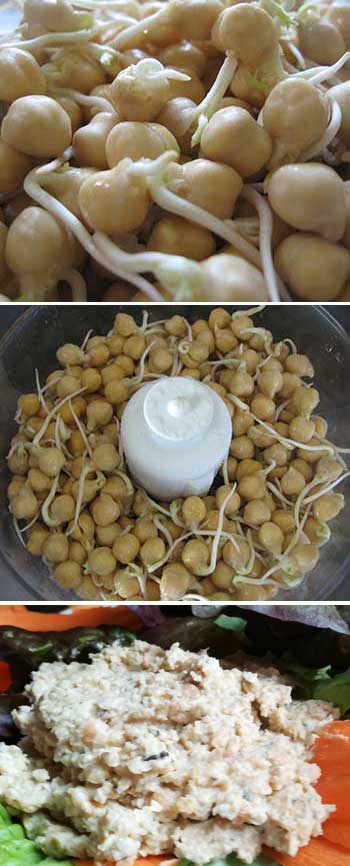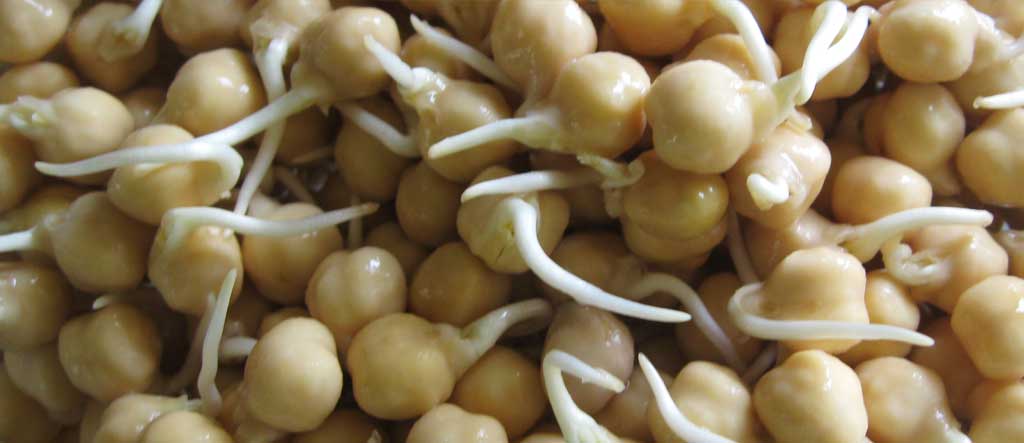
To sprout chickpeas all you need is some dried chickpeas, water, a large bowl, a colander or sieve, time and patience.
Equipment: You can use a sprouting jar or a colander and a larger bowl.
Soak time: 8 – 12 hours —Soaking initiates the sprouting process.
Rinse and drain: at least every 8 hours, this improves the taste of your sprouts.
Harvest: 2 – 4 days. A longer sprout is preferred when eating your sprouts raw – generally improves digestion.
If you are going to cook some of your sprouts, a shorter tail is preferred. Bear in mind that sprouting will reduce the required cooking time. I sometimes grind the sprouts into a meal and add to a veggie loaf or burger for an interesting texture.
Yield: 1 cup of dried chickpeas will yield 2 cups of sprouts
Chickpeas are rich in protein, folate, zinc, and potassium. Sprouting increases nutritional values by up to 700%
To sprout Chickpeas:
Ingredients:
- 1 cup of dried chickpeas
- Pinch of unrefined sea salt
- Water
Directions:
- Rinse 1 cup of chickpeas in a colander or sprouting jar. Remove any damaged or broken chickpeas.
- Place your chickpeas in a bowl with 2 – 3 cups of water and a pinch of unrefined sea salt and leave to soak overnight, or for at least 8 hours.
- Drain the chickpeas in a colander or sprouting jar and rinse thoroughly.
- Evenly spread the chickpeas across the bottom of the colander. Sit the colander in a larger bowl and cover with a cotton tea towel. Or if you are using a sprouting jar leave to stand inverted at a tilt so that excess water can drain away.
- Rinse and drain the chickpeas 2 to 3 times a day, or every 8 hours. Sprouts taste fresher and sweeter with regular rinses. Cover and set aside.
- A short tail will usually appear by the 2nd day. Repeat the process for the next 3 – 5 days. Be careful when rinsing as the tails are easily broken.
- Taste your sprouts each time you rinse them so you are familiar with how longer sprouting time affects taste.
- When your chickpeas are ready give them a final rinse and drain well.
- You can pick out any skins that have come loose, especially if you are adding to salads. The outer skins are edible and contain the highest concentrations of antioxidants found in chickpeas, for this reason I leave them on when making a hummus.
- Allow your chickpea sprouts to air dry, then refrigerate for up to 1 week.
Serving ideas:
- Sprouted chickpeas taste slightly sweet and nutty and are just as versatile as cooked chickpeas.
- Puree sprouted chickpeas with fresh garlic, olive oil, tahini and lemon juice to make a nutritious raw hummus.
- Add freshly sprouted chickpeas to salads. They combine well with curry flavours as well as mint or Italian seasonings.
- You can also cook your sprouted chickpeas; try steaming them for 10 minutes for a protein rich side dish.
- For a healthy snack toss them in olive oil with spices/seasoning of choice, and bake until golden brown and crunchy.
For maximum nutrition sprouted chickpeas are best eaten raw.
